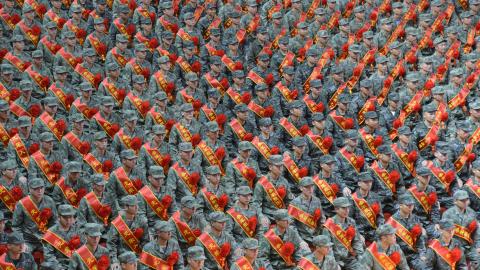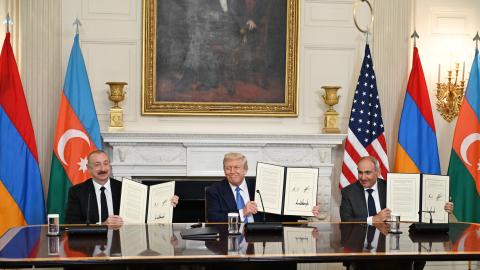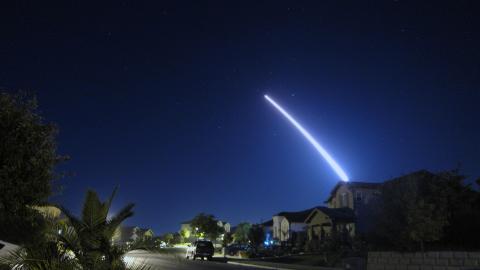Bad ideas in Washington famously don’t die; they just hibernate and then come out of their caves every so often. The latest bad idea comes from a Andrew Jarocki, a graduate student at Georgetown University. He recommends that we unilaterally kill nearly 60% of our nuclear Triad. But instead of being posted by a progressive disarmament publication, the American Conservative published this essay, resurrecting an idea of killing our ICBM leg of the Triad, previously proposed by the CATO Institute in 2016 and the Union of Concerned Scientists in 2020. When Congress in 2022 last voted on such an idea, the House voted 308-116 to build the new Sentinel ICBM, a resounding pro-ICBM vote and crushing defeat of a proposal by Representative Garamendi (D-CA).
The issue is whether the United States should build a new ICBM force given our Minuteman III arsenal is now 53 years old and cannot be sustained for much beyond 2030-35. As Senator Jean Shaheen (D-NH) explained, keeping old legacy systems without a plan to replace them runs the risk of America’s leaders waking up one day and finding a large number of the country’s nuclear systems don’t work. Thus, the ICBM and Triad modernization choice is simple: either build a new ICBM and other elements of the Triad or as a former commander of US strategic forces explained we have to get out of the nuclear business.
Jarocki admits that Russia and China also know the US would have enough retaliatory force to obliterate Russia or China. But for some strange reason, even knowing this nuclear fact of life, in a crisis Jaroki thinks it makes perfect sense for Russia and China to be inclined to strike our ICBMs, knowing they would be committing suicide as a result. A strike that by its nature would have to involve nearly 1000 warheads---to strike all 450 silos and 45 launch control centers.
Jarocki makes much of computer glitches in 1979-80 that warned of a Soviet attack which turned out to be a false alarm. He apparently thinks that it keeps occurring when in fact it has not occurred since 1979-80. One of those false alarms was that a submarine launched ballistic missile was on its way to hit the United States—but given the relative inaccuracy of the missile at the time, there was no danger the US ICBM fields were at risk. In any case, the warning never reached the White House, the US warning assessment process worked, within minutes it was determined the warnings were false, and the US nuclear guns stayed in their holsters. A subsequent Senate Armed Services Committee investigation and report determined that a subsequent computer technology fix eliminated the problem.
The window of vulnerability was genuine. The concern was based on the following scenario: the USSR could threaten to use some 2-3000 warheads of a projected 13,000+ inventory and with such a strike, eliminate most of the 1050 US land-based missiles. These ICBMs were at the time the only part of the US nuclear arsenal with sufficiently high accuracy able to hold at risk key USSR targets, including USSR leadership and heavy missile silos, highly valued by the Soviets.
With more than 10,000 warheads left in their arsenal with which to follow-up, the fear was that Moscow could then coerce the US to standdown as America’s remaining nuclear forces could successfully eliminate only soft Soviet targets such as Soviet cities, exactly however what the Soviets could also do with American cities but also multiple additional targets with their remaining accurate forces. With our ICBMs gone, we could keep launching at Soviet cities and not key military and political targets and only succeed in getting our own cities burned to the ground.
Today, assuming Russia is observing the New START agreement, Moscow probably has some 2200-2400 warheads deployed, on bombers, submarines even those in port or bastion, and on alert silo and rail garrison ICBMs. Although the official New START deployed number is limited to 1550, bombers can hold as many weapons as they can carry—gravity bombs and cruise missiles—and still only count under the treaty as “one.” But even with this force, to allocate 1000+ of their most accurate warheads to taking out the US nearly 500 ICBM targets, makes no sense.
A 2018 study “Intercontinental Ballistic Missiles and Their Role in Future Nuclear Forces” by Dr. Dennis Evans and Dr. Jonathan Schwalbe published by the Air University went through such calculations in some detail and determined that a massive, pre-emptive counterforce attack by Russia, makes no strategic sense. For example, taking out 400-450 ICBM silos and their related launch control centers would cost the Russians some 1200 warheads explains the study, but still leave the US with still a major retaliatory force with which to deter any further Russian aggression. The study concluded: “Analysis indicates that a well-designed triad is superior to a bomber-SSBN dyad in terms of the post-exchange balance of weapons after an enemy counterforce attack, survivability against a small enemy attack, and the price to attack imposed on a foreign great nuclear power.”
Even more importantly, the Russian nuclear doctrine today was developed in 1999 following a decree by then President Yeltsin who called on the Russian military industry to develop small scale, highly accurate, battlefield capable nuclear weapons, as part of an “escalate to win” strategy to win conventional conflicts with the limited use of nuclear weapons.
Precisely what Putin has serially threatened to do in Ukraine.
Such a Russian strategy does not envision striking the continental United States with a massive strike but regional targets in the theater of conflict such as airbases and seaports, or command and control and Cyber centers. In such circumstances, the US ICBM force will be totally survivable and due to its high accuracy and quick response time, be available for retaliatory strikes, with single warhead payloads suitable to regional limited conflicts, precisely what Putin thinks he can wage with limited nuclear strikes and win.
As for why the US took down its Peacekeeper 10 warhead ICBMs, it was not that the US decided we did not need ICBMs. The START II treaty had been signed by Presidents Bush and Yeltsin in January 1993 and contained within it a ban on mirved land-based ICBMs. The Russian Duma did not withdraw from the treaty in 2002. In fact, it was in 1999 the DUMA decided to ratify it only with an added provision to require the US to keep all of its missile defense work in the laboratory, a requirement the United States Senate would never accept, especially after already approving the treaty in its original form with a modest extension of the time required for implementation. Reducing the Peacekeeper was necessary not only because of the MIRV ban but we had to fit under the 1550 warhead limit which allowed the US 400 ICBM warheads. Bomber and submarine forces were also curtailed as the US force of roughly 6000 allowable deployed strategic nuclear warheads was cut to 1550, a 75% reduction.
The TRIAD was developed out of a reasonable concern by USAF Chief of Staff General Curtis LeMay that a US deterrent force susceptible to Soviet pre-emption was not stabilizing. At the time the US bomber gravity bombs were stored at 14 military bases and as soft targets, could be eliminated by Moscow, leaving the US bomber force without effect.
LeMay pushed the development of silo-based ICBMs which would constitute a highly prompt and accurate deterrent, while the Navy simultaneously developed a sea-based submarine leg of the TRIAD capable of continuous patrol at sea of a significant percent of our day-to-day nuclear deterrent forces. As such, no Soviet disarming strike could succeed, adding considerable stability to the strategic balance.
Center for Military Modernization Video on Sentinel ICBM
Similarly, a superior US deterrent force kept Soviet forces from intervening against Israel in the 1973 Mideast War, while the Reagan nuclear modernization effort successfully got Moscow to eliminate all its SS-20 nuclear missiles in Europe and the Far East, and then led to the dramatic cut in nuclear forces of nearly 90% under the START treaty process, propelled by a Peace Through Strength strategy initiated in 1981 by President Reagan.
The US has tried unilateral restraint. In 1991, President Bush withdrew US short-range regional nuclear forces from the Korean peninsula. Don Oberdorfer of the Washington Post wrote at the time that the move was certain to meet the North Korean demand that without such a withdrawal of US nuclear forces, Pyongyang could not possibly allow the IAEA and United Nations to fully inspect the North’s nuclear “energy” program to make sure it was within the confines of the NPT or Nuclear Non-Proliferation Treaty.
Similarly, to what Iran is seeking to do, the North used negotiations as a camouflage to deflect attention from its nuclear weapons work, while claiming to be all for de-nuclearization of the Korean peninsula. New estimates by Guy Hecker in his new book are that the North has 50 nuclear warheads, hardly what the US envisioned in 1991 when we removed our regional nuclear forces from the Korean peninsula..
The US faces four serious enemies of which three are nuclear armed. North Korea, China, and Russia all work together to advance their nuclear forces, while also militarily working closely with Tehran, which seeks nuclear arms. To deter the US must remain serious and remember that the mistakes of the past, have to be carefully understood or can be repeated with very bad results.
That also requires the US understand the successes of the past and how we got here.
Peace Through Strength worked. As Reagan said, “We win, they lose.”

















